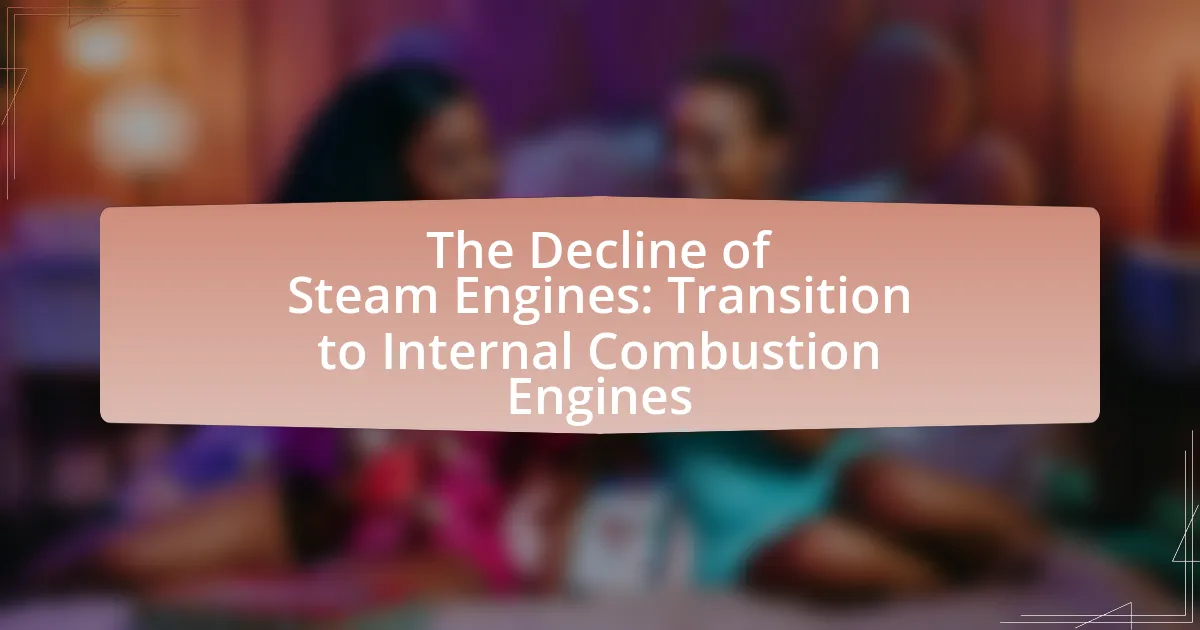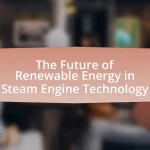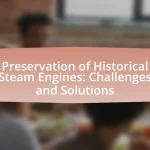The article examines the decline of steam engines and the subsequent transition to internal combustion engines, highlighting the technological advancements that facilitated this shift. Key factors include the superior efficiency, flexibility, and lower operational costs of internal combustion engines compared to steam engines, as well as economic influences such as the decreasing cost of oil and changing market demands. The article also discusses the social implications of this transition, including urbanization and labor market shifts, while addressing the environmental impact and future trends in transportation technology. Overall, it provides a comprehensive overview of the factors that led to the obsolescence of steam engines and the rise of internal combustion technology.
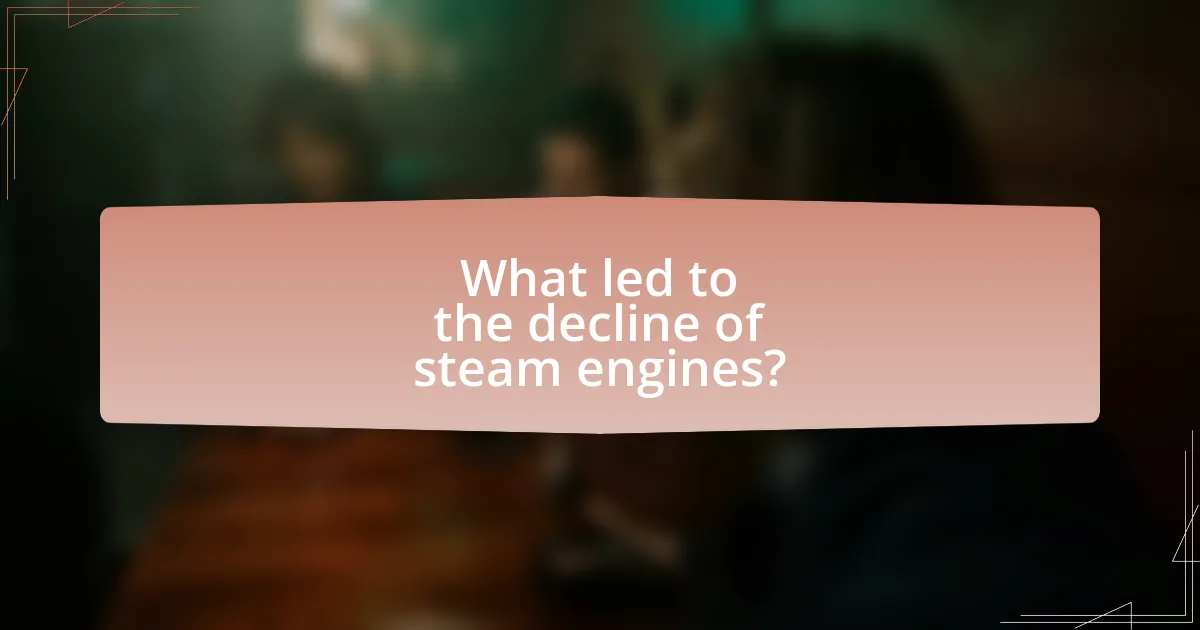
What led to the decline of steam engines?
The decline of steam engines was primarily driven by the rise of internal combustion engines, which offered greater efficiency and flexibility. Internal combustion engines, developed in the late 19th century, provided higher power-to-weight ratios and could be used in a wider variety of applications, including automobiles and aircraft. Additionally, advancements in electrical power generation and distribution further diminished the reliance on steam engines for industrial and transportation needs. By the mid-20th century, steam engines had largely been replaced, as evidenced by the significant decrease in steam locomotive production and the transition to diesel and electric trains, which became the standard in rail transport.
How did technological advancements impact steam engine usage?
Technological advancements significantly reduced steam engine usage by introducing more efficient alternatives, particularly internal combustion engines. The development of lighter materials, improved fuel efficiency, and enhanced power-to-weight ratios in internal combustion engines made them more practical for transportation and industrial applications. For instance, the introduction of the gasoline engine in the late 19th century allowed for greater mobility and flexibility compared to the bulky steam engines, which required extensive infrastructure for water and fuel supply. Additionally, advancements in electrical engineering led to the rise of electric motors, further diminishing the reliance on steam power in various sectors. These innovations collectively contributed to the decline of steam engines, as they could not compete with the operational efficiency and convenience of newer technologies.
What innovations contributed to the decline of steam engines?
The decline of steam engines was primarily driven by the innovations of internal combustion engines and electric power. Internal combustion engines, which became widely adopted in the early 20th century, offered higher efficiency, greater power-to-weight ratios, and the ability to operate without the need for large boilers or extensive infrastructure. For instance, the introduction of the gasoline engine by Karl Benz in 1885 marked a significant shift, as it allowed for more compact and versatile vehicle designs. Additionally, advancements in electrical engineering led to the development of electric motors, which provided cleaner and quieter alternatives for transportation and industrial applications. The combination of these innovations rendered steam engines less practical and efficient, leading to their decline in favor of more modern technologies.
How did efficiency improvements in other technologies affect steam engines?
Efficiency improvements in other technologies, particularly in internal combustion engines and electrical systems, significantly diminished the relevance of steam engines. As internal combustion engines became more efficient, offering higher power-to-weight ratios and greater fuel efficiency, they provided a more practical alternative for transportation and industrial applications. For instance, by the early 20th century, internal combustion engines had surpassed steam engines in terms of operational efficiency, leading to their widespread adoption in automobiles and locomotives. Additionally, advancements in electrical technology allowed for more efficient energy transmission and utilization, further reducing the reliance on steam power. This shift was evidenced by the decline in steam locomotive production, which fell from over 20,000 units in the 1920s to less than 1,000 by the 1960s, illustrating the direct impact of these efficiency improvements on the steam engine’s viability.
What economic factors influenced the transition from steam engines?
The transition from steam engines to internal combustion engines was primarily influenced by economic factors such as the decreasing cost of oil extraction and the rising efficiency of internal combustion technology. As oil became more accessible and affordable due to advancements in drilling techniques and the establishment of a global oil market, it provided a cheaper fuel alternative compared to coal used in steam engines. Additionally, internal combustion engines offered greater power-to-weight ratios and operational efficiencies, leading to lower operational costs for transportation and industrial applications. Historical data shows that by the early 20th century, the cost of gasoline had significantly dropped, making it a more economically viable option for consumers and industries, thus accelerating the shift away from steam technology.
How did the cost of operation compare between steam engines and internal combustion engines?
The cost of operation for internal combustion engines is generally lower than that of steam engines. Internal combustion engines benefit from higher thermal efficiency and reduced fuel costs, as they typically use gasoline or diesel, which are more energy-dense compared to the coal or wood required for steam engines. Additionally, maintenance costs for internal combustion engines are often lower due to fewer moving parts and less complex systems. Historical data indicates that by the early 20th century, the operational costs of steam engines became significantly higher, leading to their decline in favor of more economical internal combustion engines.
What role did market demand play in the decline of steam engines?
Market demand significantly contributed to the decline of steam engines as industries and consumers increasingly favored more efficient and versatile alternatives, particularly internal combustion engines. The rise of automobiles and diesel-powered machinery, which offered greater fuel efficiency and lower operational costs, shifted consumer preferences away from steam technology. By the early 20th century, the demand for faster, more reliable transportation options led to a rapid decline in steam engine production, with manufacturers responding to market trends by investing in internal combustion technology. This transition was evident as sales of steam locomotives plummeted from over 20,000 units in the 1920s to less than 1,000 by the 1950s, illustrating the direct impact of market demand on the steam engine’s obsolescence.
What social changes accompanied the decline of steam engines?
The decline of steam engines led to significant social changes, including urbanization, shifts in labor markets, and changes in transportation dynamics. As steam engines became less prevalent, industries transitioned to internal combustion engines, which facilitated the growth of cities as people moved closer to industrial centers for work. This urbanization resulted in a demand for new infrastructure, such as roads and highways, which altered social interactions and community structures. Additionally, the labor market shifted as jobs in steam-powered industries diminished, while new opportunities arose in automotive and manufacturing sectors, leading to changes in workforce skills and employment patterns. The transition also influenced social mobility, as access to faster and more efficient transportation expanded opportunities for individuals and families.
How did public perception of steam engines evolve over time?
Public perception of steam engines evolved from initial fascination and admiration to eventual skepticism and decline. In the early 19th century, steam engines were celebrated for their revolutionary impact on transportation and industry, exemplified by the success of George Stephenson’s locomotive in 1825, which showcased their efficiency and power. However, as the 20th century approached, concerns about safety, pollution, and operational costs began to surface, leading to a shift in public sentiment. The advent of internal combustion engines, which offered greater efficiency and convenience, further diminished the appeal of steam technology. By the mid-20th century, steam engines were largely viewed as outdated, with their use primarily relegated to heritage railways and nostalgic contexts, marking a significant decline in their public perception.
What impact did labor shifts have on steam engine usage?
Labor shifts significantly reduced steam engine usage as industries transitioned to more efficient technologies. The movement of labor from agricultural to industrial sectors during the Industrial Revolution created a demand for faster and more reliable power sources. As factories sought to maximize productivity, the limitations of steam engines, such as their need for constant fuel and water supply, became apparent. Consequently, the introduction of internal combustion engines, which offered greater efficiency and flexibility, led to a decline in steam engine reliance. Historical data shows that by the early 20th century, internal combustion engines had largely supplanted steam engines in transportation and manufacturing, reflecting the broader labor shifts towards mechanization and efficiency.

How did internal combustion engines emerge as a dominant technology?
Internal combustion engines emerged as a dominant technology due to their efficiency, compact size, and versatility compared to steam engines. The development of the four-stroke cycle by Nikolaus Otto in 1876 significantly improved engine performance and fuel efficiency, making internal combustion engines more practical for various applications, including automobiles and machinery. Additionally, advancements in materials and manufacturing processes during the late 19th and early 20th centuries facilitated mass production, further enhancing their adoption. By the early 20th century, the introduction of affordable vehicles, such as the Ford Model T in 1908, solidified the internal combustion engine’s position as the preferred power source, leading to a decline in steam engine usage.
What are the key advantages of internal combustion engines over steam engines?
Internal combustion engines offer several key advantages over steam engines, primarily in efficiency, size, and operational flexibility. Internal combustion engines convert fuel directly into mechanical energy, achieving thermal efficiencies of around 25-30%, compared to steam engines, which typically operate at 10-15% efficiency due to energy losses in heat conversion and steam generation. Additionally, internal combustion engines are more compact and lighter, allowing for greater design flexibility in vehicles and machinery. This compactness facilitates easier integration into various applications, from automobiles to portable equipment. Furthermore, internal combustion engines can start and stop quickly, providing operational flexibility that steam engines, which require time to build up steam pressure, cannot match. These advantages contributed significantly to the decline of steam engines in favor of internal combustion technology during the 20th century.
How does the efficiency of internal combustion engines compare to steam engines?
Internal combustion engines are generally more efficient than steam engines, with thermal efficiencies typically ranging from 25% to 30%, while steam engines usually operate at efficiencies of about 10% to 15%. This difference arises from the internal combustion engine’s ability to convert fuel directly into mechanical energy with fewer energy losses, whereas steam engines lose significant energy through heat in the steam generation and condensation processes. Historical data supports this comparison, as advancements in internal combustion technology have led to improved fuel efficiency and performance, contributing to the decline of steam engines in favor of internal combustion engines in various applications.
What are the maintenance requirements for internal combustion engines versus steam engines?
Internal combustion engines require regular oil changes, air filter replacements, and spark plug inspections, while steam engines necessitate frequent boiler inspections, water treatment, and maintenance of steam lines. Internal combustion engines typically need maintenance every 3,000 to 7,500 miles, depending on usage, while steam engines require more extensive maintenance due to their complex systems and safety regulations, often involving daily checks and periodic overhauls. The differences in maintenance stem from the operational principles; internal combustion engines rely on fuel combustion and lubrication, whereas steam engines depend on high-pressure steam and water management, leading to distinct maintenance protocols.
What industries were most affected by the transition to internal combustion engines?
The industries most affected by the transition to internal combustion engines were transportation, manufacturing, and agriculture. The transportation sector experienced a significant shift as railroads and steamships transitioned to gasoline and diesel engines, enhancing efficiency and reducing operational costs. In manufacturing, the adoption of internal combustion engines allowed for more flexible production methods and the rise of motor vehicles, which transformed logistics and supply chains. Agriculture also saw a major impact, as tractors and other machinery powered by internal combustion engines replaced traditional horse-drawn methods, increasing productivity and changing farming practices. These transitions collectively marked a pivotal change in industrial operations and economic structures during the early 20th century.
How did transportation sectors adapt to internal combustion engines?
Transportation sectors adapted to internal combustion engines by redesigning vehicles, enhancing infrastructure, and shifting operational practices. Automobiles and trucks replaced horse-drawn carriages and steam-powered vehicles, leading to the development of assembly line production methods, exemplified by Henry Ford’s Model T in 1913, which revolutionized mass production. Railroads transitioned from steam locomotives to diesel-electric engines, improving efficiency and reducing operational costs. Additionally, the rise of highways and fueling stations supported the growing use of internal combustion engines, facilitating long-distance travel and freight transport. These adaptations collectively transformed the transportation landscape, making it faster and more efficient.
What role did agriculture play in the adoption of internal combustion engines?
Agriculture significantly accelerated the adoption of internal combustion engines by increasing the demand for more efficient farming equipment. The introduction of internal combustion engines allowed for the development of tractors and other machinery that could perform tasks faster and with less labor compared to traditional steam engines. For instance, by the early 20th century, tractors powered by internal combustion engines began to replace horse-drawn plows, leading to increased productivity on farms. This transition was driven by the need for greater efficiency in food production to support a growing population, as evidenced by the fact that by 1930, over 50% of U.S. farms had adopted tractor technology, showcasing the pivotal role agriculture played in this technological shift.
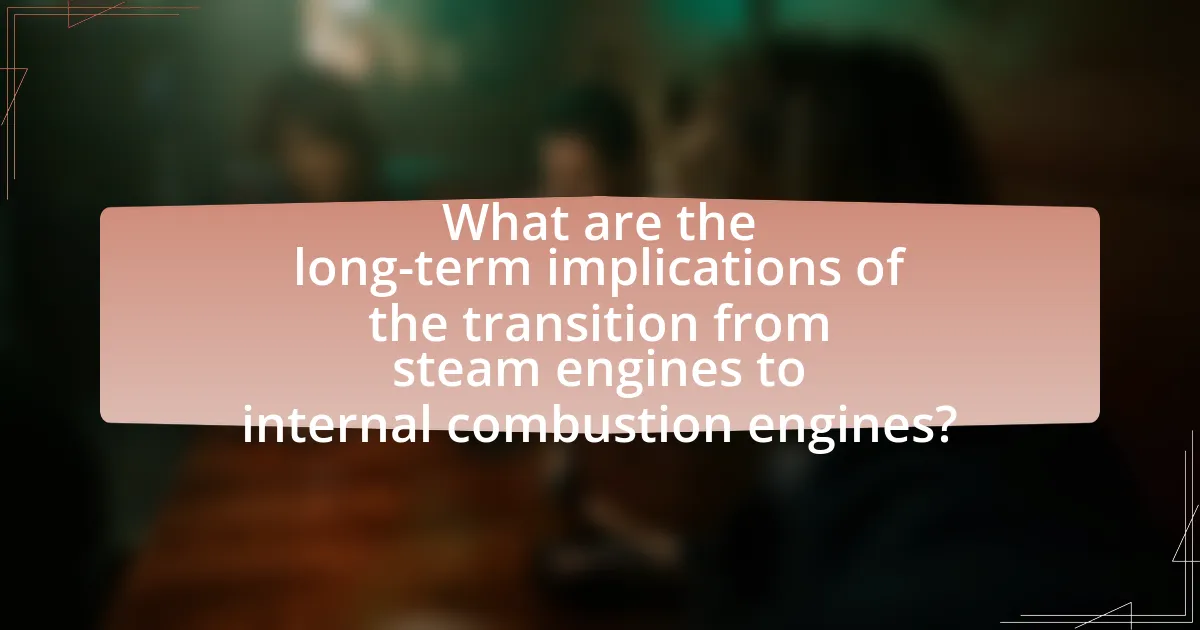
What are the long-term implications of the transition from steam engines to internal combustion engines?
The long-term implications of the transition from steam engines to internal combustion engines include increased efficiency, greater power-to-weight ratios, and a shift towards more versatile applications in transportation and industry. Internal combustion engines, which became prevalent in the early 20th century, offered significant advantages over steam engines, such as quicker start-up times and the ability to operate without the need for extensive infrastructure like railways. This transition facilitated the rise of automobiles and airplanes, fundamentally altering transportation dynamics and urban development. Additionally, the internal combustion engine’s reliance on fossil fuels has led to long-term environmental challenges, including air pollution and climate change, as evidenced by rising carbon emissions linked to increased vehicle usage since the 1950s.
How has the transition influenced modern engineering practices?
The transition from steam engines to internal combustion engines has significantly influenced modern engineering practices by prioritizing efficiency, compact design, and versatility in power generation. This shift led to the development of more efficient energy conversion processes, as internal combustion engines typically convert fuel to energy with higher thermal efficiency compared to steam engines, which often waste energy through heat loss. Additionally, the compact size of internal combustion engines allowed for more flexible applications across various industries, from automotive to aviation, enabling engineers to innovate in design and functionality. This transition also spurred advancements in materials science and thermodynamics, as engineers sought to optimize engine performance and durability, ultimately shaping the trajectory of modern engineering disciplines.
What lessons can be learned from the decline of steam engines?
The decline of steam engines teaches the importance of technological adaptability and innovation in transportation. As steam engines became less efficient compared to internal combustion engines, industries that failed to transition faced obsolescence. For instance, by the early 20th century, steam locomotives were largely replaced by diesel and electric trains, which offered greater efficiency and lower operational costs. This shift illustrates that embracing advancements in technology is crucial for maintaining competitiveness and relevance in any industry.
How do current technologies reflect the evolution from steam to internal combustion engines?
Current technologies reflect the evolution from steam to internal combustion engines through advancements in efficiency, power output, and versatility. The transition from steam engines, which relied on external combustion and large, heavy machinery, to internal combustion engines marked a significant shift towards more compact and efficient designs. For instance, internal combustion engines can achieve higher thermal efficiencies, often exceeding 30%, compared to steam engines that typically operated below 10% efficiency. Additionally, modern technologies such as hybrid and electric vehicles demonstrate the ongoing evolution of engine design, integrating principles from both steam and internal combustion systems while emphasizing sustainability and reduced emissions. This evolution is evidenced by the widespread adoption of internal combustion engines in transportation, which has revolutionized mobility since their introduction in the late 19th century.
What future trends might emerge from the decline of steam engines?
The decline of steam engines is likely to lead to increased reliance on internal combustion engines and electric propulsion systems. As steam technology becomes obsolete, industries will shift towards more efficient and environmentally friendly alternatives, such as electric vehicles and hybrid systems. This transition is supported by the growing emphasis on reducing carbon emissions and improving energy efficiency, as evidenced by global initiatives like the Paris Agreement, which aims to limit global warming and promote sustainable energy sources. Additionally, advancements in battery technology and renewable energy sources will further accelerate this trend, making electric propulsion more viable and attractive for transportation and industrial applications.
How might electric and alternative fuel technologies impact the legacy of internal combustion engines?
Electric and alternative fuel technologies are likely to redefine the legacy of internal combustion engines by significantly reducing their prevalence and relevance in the automotive industry. As of 2023, electric vehicles (EVs) accounted for approximately 10% of global car sales, a figure projected to rise as governments implement stricter emissions regulations and consumers increasingly favor sustainable options. This shift is evidenced by major automakers committing to phasing out internal combustion engines in favor of electric models, with companies like General Motors and Ford announcing plans to transition to an all-electric lineup by 2035. Consequently, the historical significance of internal combustion engines may diminish as electric and alternative fuel technologies become the standard for transportation, marking a pivotal change in automotive engineering and environmental impact.
What are the potential environmental implications of this transition?
The transition from steam engines to internal combustion engines has significant environmental implications, primarily due to increased greenhouse gas emissions. Internal combustion engines typically emit higher levels of carbon dioxide and nitrogen oxides compared to steam engines, contributing to climate change and air pollution. For instance, the U.S. Environmental Protection Agency reported that transportation accounts for nearly 29% of total greenhouse gas emissions, with internal combustion vehicles being a major contributor. Additionally, the reliance on fossil fuels for internal combustion engines leads to resource depletion and habitat destruction associated with oil extraction. This transition, while improving efficiency and power, has resulted in a net negative impact on air quality and global warming.
What practical considerations should be taken into account regarding the transition from steam engines?
The transition from steam engines to internal combustion engines requires careful consideration of infrastructure compatibility, fuel availability, and maintenance requirements. Infrastructure must be adapted to accommodate the different operational needs of internal combustion engines, such as fuel storage and distribution systems, which were not necessary for steam engines. Additionally, the availability of gasoline and diesel fuel must be ensured, as these fuels differ significantly from the coal used in steam engines. Maintenance practices also need to be updated, as internal combustion engines typically require different servicing techniques and parts compared to steam engines. Historical data shows that the shift to internal combustion engines in the early 20th century led to significant changes in transportation and industry, highlighting the importance of these practical considerations.
